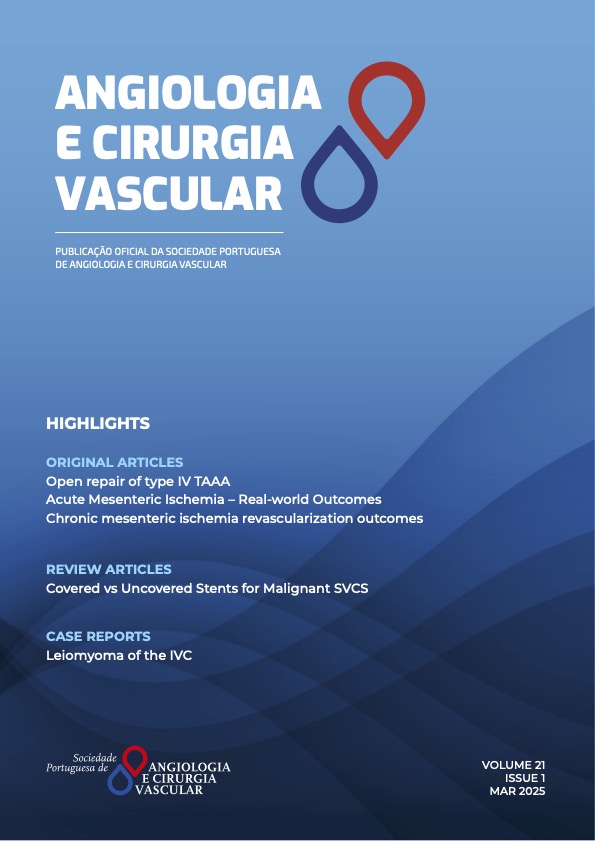Open repair of type IV thoracoabdominal aortic aneurysms: a real-world experience in the endovascular era.
DOI:
https://doi.org/10.48750/acv.626Palavras-chave:
Aortic Aneurysm, Thoracoabdominal type IV, Open repairResumo
INTRODUCTION: Currently, type IV thoracoabdominal aortic aneurysms (TAAA-IV) are treated primarily by endovascular repair. Despite the increased morbidity, there is still a role for open surgery in selected patients. This paper aims to present a descriptive analysis and outcome evaluation of open repair for TAAA-IV in our institution, where endovascular repair is generally the first-line treatment option.METHODS: An observational, descriptive, and retrospective cohort analysis was conducted, including all patients treated for asymptomatic TAAA-IV in the last 15 years (2008-2023). Demographic data, comorbidities, procedure protocols, complications, and early mortality were described and analyzed.
RESULTS: The initial cohort included 38 patients. Ten emergent cases and four due to inconsistent records were excluded, resulting in a final population of 24 subjects. Twenty-two were men (92%), with a mean age of 68 years (standard deviation, 8 years) and a mean aortic diameter of 70mm (standard deviation, 15mm). All patients were submitted to paramedian laparotomies with medial visceral rotation. The approach to visceral and renal arteries varied, primarily due to the left renal artery (bypass in five, abandoned due to atrophied kidneys in two, reimplantation in 16 patients). The median length of hospital and ICU stay was 7 and 20 days, respectively. The most frequent complication was acute kidney injury (AKI) in 87%, being transient in 75%. Hemodialysis was needed in 21%, but permanent need for hemodialysis was only noted in 4%. Infectious complications occurred in 29%, mainly lower respiratory infections (17%). Two patients (8%) had cardiac complications (acute myocardial infarction and non-ischemic cardiogenic shock). The overall intra-hospital mortality rate was 21% (5/24), with the following time frame: intra-operative – two cases; first 24 hours, one case; between day 1 and day 30, one case; and beyond 30 days, one case.
CONCLUSION: In this low-volume cohort, treated over a long time period, a high mortality rate was observed, which may confirm the dependence between results and surgical/post-operative care volume and experience. AKI was the most frequent complication, being transient in most cases. The main limitations of this study are the use of different treatment strategies over a long period of time, reporting bias, and the small sample size. Finally, we deem it necessary to report the results of open repair, thereby raising the issue of how to manage small cohorts of patients requiring open repair in an era where such cases are becoming increasingly rare.
Downloads
Referências
Kieffer E, Chiche L, Godet G, Koskas F, Bahnini A, Bertrand M, et al. Type IV thoracoabdominal aneurysm repair: predictors of postoperative mortality, spinal cord injury, and acute intestinal ischemia. Ann Vasc Surg. 2008;22:822-8
Moulakakis KG, Karadaris G, Antonopoulos CN, Kakisis J, Klonaris C, Prewenza O, et al. Open repair of thoracoabdominal aortic aneurysms in experienced centers. J Vasc Surg. 2018;68:34-45
Bicknell CD, Cowan AR, Keile MI, Mansfield AO, Cheshire NJ, Wolfe JH. Renal dysfunction and prolonged visceral ischaemia increase mortality rate after suprarenal aneurysm repair. Br J Surg. 2003;9:014-26.
Patel VI, Ergul E, Conrad MF, Cambria M, LaMuraglia CM, Kwolek CJ, et al. Controlled favorable results with open surgical repair of type IV thoracoabdominal aortic aneurysms. J Vasc Surg. 2011;53:1492-8
Latz CA, Patel VI, Cambria RP, Ergul EA, Lancaster RT, LaMuraglia GM, et al. Durability of open surgical repair of type IV thoracoabdominal aortic aneurysm. J Vasc Surg. 2019;69:661-70.
Coselli JS, Bozinovski J, LeMaire SA. Open surgical repair of 2286 thoracoabdominal aortic aneurysms. Ann Thorac Surg. 2007;83:5862-4
Schepens MA, Dekker E, Hamerljnick RP, Vermeulen FE. Survival and aortic events after graft replacement for thoracoabdominal aortic aneurysm. Cardiovasc Surg. 1996;4:713-9
Oderich CS, Ribeiro M, Reis de Souza L, Hofer J, Wigham J, Cha S. Endovascular repair of thoracoabdominal aortic aneurysms using fenestrated and branched endosparts. J Thorac Cardiovasc Surg. 2017;153:532-541








